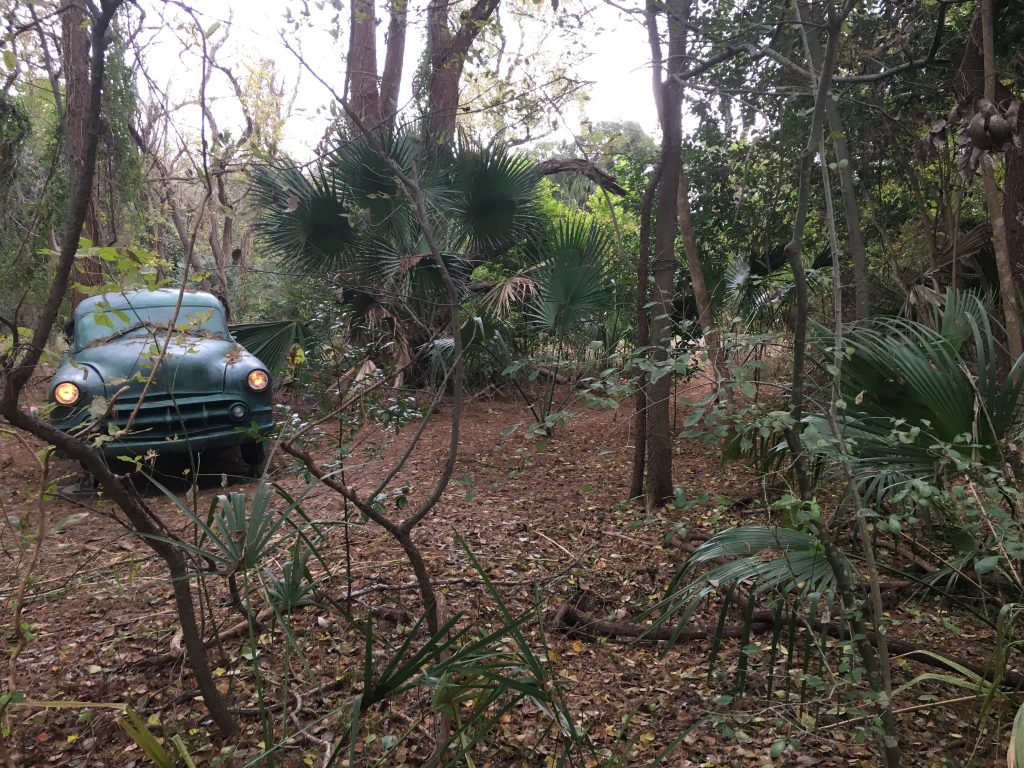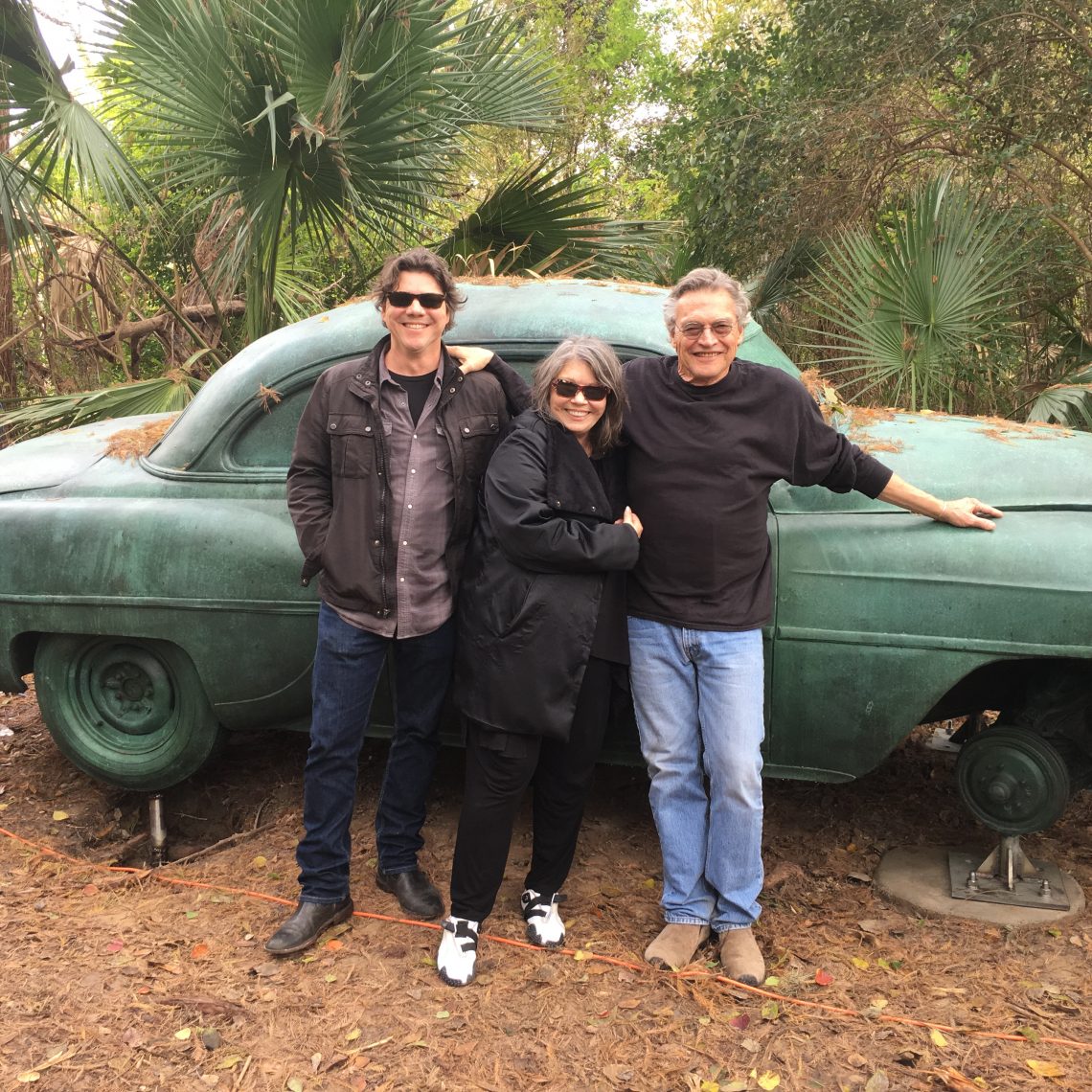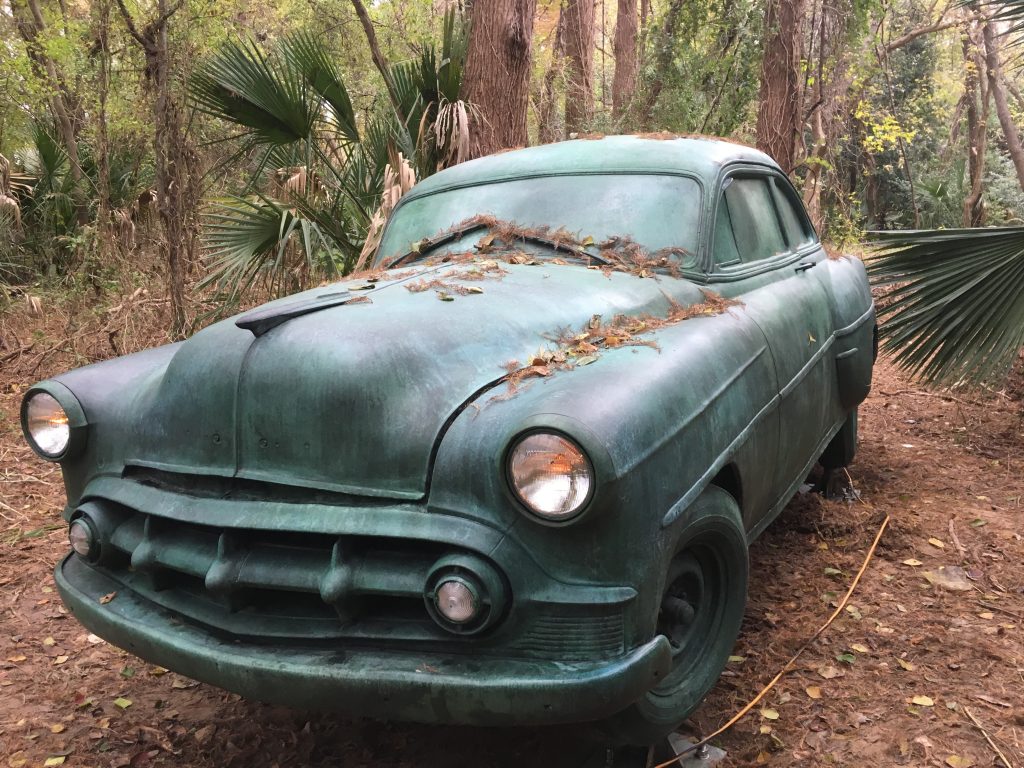By Richard Skanse
If you were to somehow stumble upon Terry Allen’s Road Angel unawares in the dead of night, odds are it’d scare the hell out of you. You’d hear it first, coming from somewhere in the trees just off the side of the road, about 100 feet away: the ghostly peel of a pedal steel, a voice, or maybe just the disconcerting sound of gnashing, gnawing, and crunching. Creeping closer, curiosity squashing common sense and the sound growing louder by the step, you’d spy the eerie red glow of taillights peeking through the trees like demon eyes — and then the car itself, an early ’50s Chevy hardtop coupe, copper green and covered in leaves and catkins. The headlights burn as bright in the dark as the radio blares loud, but the opaque windows — all the same color as the body — make it impossible to see inside, the doors appear to be welded shut and the passenger-side front tire is missing and nowhere in sight. It all feels like something right out of the Twilight Zone, only that’s not Rod Sterling’s voice now emanating from the belly of the verdigris metal beast: It’s the raspy howl of the Wolfman of Del Rio.
Mind, that’s Road Angel in the dark — an encounter that’s purely hypothetical at present, given that the grounds of Austin’s Laguna Gloria close at 5 p.m. But add daylight, and the thrilling mystery and chill factor of Allen’s creation — the newest addition (opening tomorrow, Dec. 17) to the museum’s Betty and Edward Marcus Sculpture Park — dissipates not a whit. The surreality of it all is just as palpable when you can see and appreciate the car’s beauty in all of its patina glory. You can even walk right up to it and feel it — an understandable no-no with a lot of pieces in the park, but Allen doesn’t mind; he likes the way human touch adds extra character to the finish. And save for the working head and taillights, every inch of the car — tires included — is cast entirely from bronze. It’s actually not a “real” 1953 Chevy at all, but rather an astonishingly detailed replica.
“We found the [actual] car up around Round Rock,” Allen says, noting that he went searching specifically for a ’53 model only because that was the year of his own first car. “Some guy had it; it was just a shell, didn’t have an engine or anything inside of it. So we bought it and took it out to Deep in the Heart Art Foundry in Bastrop. Bale [Allen’s son, also a visual artist] kind of turned me onto them because he’d been doing some of his bronze tumbleweeds out there. Which was incredibly fortuitous for me, because it was close, and they really did an incredible job.”
How exactly does one make a bronze casting of an entire car? One piece at a time.
“First, they make a rubber mold of the entire car, but it’s in sections, because you can’t cast anything that big — you have to break it down into increments,” explains Allen, who knows a thing or two about working big: among his many other notable public works are the sculptures “Wish,” a two-story tall wishbone at DFW Airport, and “Belief,” a 20×20-foot giant leaf at the University of Cincinnati. Once finished, the rubber molds are used to make wax duplicates of the different pieces, each of which is then surrounded by a ceramic shell. When the shell hardens, the wax is melted away and replaced by molten bronze (a 90-percent copper alloy). The metal solidifies, the shell is cracked open, and there’s your solid bronze hunk of trunk or other car chunk, ready to be welded back together with the other pieces.
“Basically out of patchwork, they rebuild the car exact,” Allen says. Except of course for that missing front tire, which was cast separately, fitted with its own speaker and auctioned off earlier. “So that tire does exist, it’s just somewhere else! Some woman who lives on the other side of the lake bought it.”
As impressive as it may be on its own, though, the whole bronze-casted Chevy is only just the shell of the art piece. It’s the hours and hours of sound recordings, played through the custom speaker system hidden inside, that really gives Road Angel its heart and soul.
“I’ve invited over a 100 people to do things for it, and it’s going to be ongoing — I’m going to add to it every year,” Allen explains, noting that the entire archive will be owned by Laguna Gloria (it’s all part the package). “I’ve got 50 (submissions) so far, about five hours of stuff, and there’s still more stuff coming in.”
That “stuff” includes songs, instrumental tracks, poems, stories, and all manner of interesting audio collages, collected from a veritable who’s who of Allen’s fellow artist and songwriting friends. Collaborators so far include his sons Bukka and Bale Allen, Lloyd Maines, Joe and Sharon Ely (Joe singing his own “Because of the Wind,” Sharon playing “Greensleeves” on piano), Steve Earle, Shawn Colvin, Delbert McClinton, Clay McClinton, Rodney Crowell, John Hadley, and Inara George, daughter of the late Lowell George of Little Feat (who covered Allen’s “New Delhi Freight Train” on their 1977 album Time Loves a Hero, two years before Allen cut it himself for his landmark Lubbock (on everything)). Tamara Saviano, record producer and author of Without Getting Killed or Caught: The Life and Music of Guy Clark, contributed a spoken-word piece, and Texas writer Joe Nick Patoski produced a virtual station-to-station roll across the dial circa the golden age of Border Radio; he’s the one responsible for the aforementioned flashback of Wolfman Jack.
“I just told everybody, ‘Do anything you want to do that people will hear coming out of the car,’” says Allen. And though there was no stipulation that the submissions had to actually be about cars, a lot of them just sort of turned out that way. Shawn Colvin turned in a cover of Bruce Springsteen’s “Racing in the Streets,” Inara George a newly written song called “Sex in Cars,” and Oklahoma songwriter John Hadley a story about his first set of wheels, a ’51 Mercury.
“There’s something about that whole kind of mythology of the car, the American car, that I think just draws incredible stories out of people,” muses Allen. “But this piece isn’t about nostalgia — it’s about memory. I used to say that I didn’t have a memory until I got my first car, because there was no reason to have a memory before that. My first car came at the same time that rock ’n’ roll hit, and the two were just the same thing: getting out on the highway, going as fast as you could go with the radio up as loud as it would go, and hearing stuff that you’d never heard before. No pun intended, but it was an incredible kind of vehicle for yourself into the world.”
Louis Grachos, director of the Contemporary Austin and Laguna Gloria, is a decade and change younger than Allen, but he can still relate. “A lot of us, especially from my generation, associate beautiful memories to these old cars,” he says. “My father’s first car was a ’55 Chevy that looked pretty close to this, so it resonates … it hits you in a place that’s pretty sweet. Road Angel does that. It’ll mean different things to different people, and as different generations experience it, it’ll mean a whole different thing to them, too. And those associations are going to be interesting to figure out, just seeing how young kids really start to see this and read it and understand it.”
It was two summers ago that Grachos first reached out to Allen about doing a project for Laguna Gloria. He smiles as he recalls his introduction to Allen’s work via an installation called Trees, a collection of towering metal trees (one playing music, another poetry) at the University of California in San Diego. “One of the things I’ve always admired about Terry’s work is how he integrates all of his art forms — his visual art, his sculpture, his performance, his poetry, and his music,” Grachos says. “I just couldn’t think of a better artist to invite to do a project here.” So he took a trip out to Allen’s studio in Santa Fe to discuss possible ideas, and was immediately interested in a drawing Allen had made of a somewhat ominous looking abandoned car — in part inspired by a scene from Psycho. When Allen mentioned his desire to cast one in bronze and add sound, Grachos was sold.
“I just loved the fact that the city of Austin could not only have a great piece of artwork, but one that also speaks to its music history,” Grachos says, then adds with a laugh, “and, it’s just so fucking cool!”

Another view of Terry Allen’s “Road Angel,” now a permanent resident of the Betty and Edward Marcus Sculpture Park at Laguna Gloria. (Photo by Richard Skanse)
Austin ended up getting more than just a cool Terry Allen piece, though: it got the acclaimed songwriter and Guggenheim Fellowship winner himself — at least part time. Terry and his wife, actress and writer Jo Harvey Allen, bought a house in Austin (where both their sons and grandkids all live) last February. “We’re keeping our place in Santa Fe,” Allen says, “but I’ve had so much work here — I’ve been here since the middle of October just working on this — that it’s been great to have it.”
Local traffic conditions aside, having that Austin pad should also significantly cut down on his travel time to his next music gig: a Saturday, Jan. 14 full-band and special guests affair at the Paramount Theatre billed as “Terry Allen: Juarez & Lubbock on Everything.” It’s one of a handful of select shows he’ll be playing in the new year focusing on the songs from his seminal first two albums, 1975’s Juarez and 1979’s Lubbock (on everything) — both of which were given the 5-star reissue treatment in 2016 by the North Carolina-based boutique record label, Paradise of Bachelors.
“Those guys have been so incredible to me,” Allen enthuses. “Their company, they take so much care of everything they do — I’m knocked out by it. And they want to do a new project with me now. They’re real interested in (reissuing) Pedal Steel, but I’d kinda like to do something brand new. Which they’re open to, too.”
That comes as very welcome news, given that Allen’s last album, Bottom of the World, was released back in 2012. Not surprisingly, it was his work on Road Angel that started getting his songwriting wheels rolling again. “I’ve worked on several songs since I’ve been doing this,” he says. “Just because I’m getting so many incredible things coming in, it kind of makes your want to write.”
But a possible new record isn’t the only next big undertaking on Allen’s mind at the moment. There’s also the matter of honoring one of the last wishes of his longtime friend Guy Clark, who died at age 74 on May 17 of this year. As Saviano recounts in Without Getting Killed or Caught, Clark requested that his ashes be used in some form or fashion in a new Terry Allen sculpture. Allen admits he has no idea what that work will actually be, let alone where it will go, but figuring all that out and getting it done is high on his 2017 to-do list.
“That was his final ‘fuck you’ to me,” Allen says with a laugh. “Like, ’Here, take this!’”
The fact is, though, Clark already is a part of a Terry Allen piece — the one he just finished. Clark’s ashes may not be inside Road Angel, but his memory certainly is.
“I kept thinking of it (the car) as a ghost, somehow,” Allen says. “But I was trying to think of something else, because I just didn’t like ‘ghost.’ And actually, it was from singing Guy’s song (“Old Friends”) — that line, ‘You can’t tell the difference between an angel and a ghost” — that’s when I thought, ‘Angel! Of course!’”
Terry Allen’s Road Angel officially begins its permanent residence at Betty and Edward Marcus Sculpture Park, on the grounds of the Contemporary Austin’s Laguna Gloria Museum, on Saturday, Dec. 17, with a celebratory kickoff from noon until 2 p.m. For more information, visit http://www.thecontemporaryaustin.org/exhibitions/terry-allen-road-angel/







That is so cool! Terry Allen does it again!
Wonderful art. Great story. Thank you, Terry. Thank you, Richard.